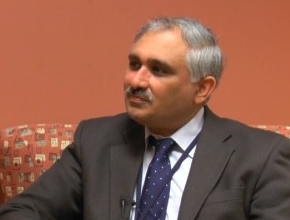References
Eikelboom JW, Connolly SJ, Bosch J, et al; COMPASS Investigators. Rivaroxaban with or without Aspirin in Stable Cardiovascular Disease. N Engl J Med. 2017 Oct 5;377(14):1319-1330. doi: 10.1056/NEJMoa1709118. Epub 2017 Aug 27. PubMed PMID: 28844192.Heart Outcomes Prevention Evaluation Study Investigators, Yusuf S, Sleight P, Pogue J, et al. Effects of an angiotensin-converting-enzyme inhibitor, ramipril, on cardiovascular events in high-risk patients. N Engl J Med. 2000 Jan 20;342(3):145-53. Erratum in: 2000 May 4;342(18):1376. N Engl J Med 2000 Mar 9;342(10):748. PubMed PMID: 10639539.
Roman Jaeschke, MD: Good afternoon. Welcome to another edition of McMaster Perspective. I would like to introduce to you Professor Sonia Anand. Sonia, maybe you could start by telling us a few words about your research interests.
Sonia Anand, MD, PhD: I started off completing my general internal medicine training here at McMaster University. In my 4th year I was interested in evidence-based medicine, so I completed my master’s degree in clinical epidemiology. From a clinical perspective, I went on to do thrombosis and then a fellowship in vascular medicine, and along the way also my PhD in clinical epidemiology.
Right now about 80% of my time is spent on research, 20% on clinical [work]. Research is split between clinical trials and classical epidemiology, so it is more focused on the determinants of cardiovascular disease. From the clinical perspective, I practice thrombosis and in my outpatient clinic I see a lot of patients with peripheral artery disease (PAD).
Roman Jaeschke: That brings us to peripheral vascular disease and a series of papers talking about treatment of peripheral vascular disease. Could you describe to us to start with what was known about efficacious treatments of that disease before you have done your current study?
Sonia Anand: We think of PAD as the “poor cousin” to coronary artery disease (CAD), meaning that most of the large trials have been done in CAD patients and we extrapolate those data and apply them to PAD. Prior to the COMPASS (Cardiovascular Outcomes for People Using Anticoagulation Strategies) trial, the standard of care in PAD included a single antiplatelet agent per day. The evidence behind that came from the Oxford Antithrombotic Trialists’ Collaboration, so meta-analyses of smaller trials. A statin therapy was extrapolated from secondary prevention, primarily CAD trials. Angiotensin-converting enzyme (ACE) inhibitors or angiotensin receptor blockers (ARBs) were also extrapolated from the broader vascular population trials, such as HOPE (Heart Outcomes Prevention Evaluation). So those 3 medications would be pharmacologic.
From the perspective of health behaviors, we know that cigarette smoking exposure is the strongest determinant in PAD, diabetes the second, and age is also very important. So we emphasize smoking cessation as much as possible in PAD.
From the perspective of intermittent claudication, walking in a walking program significantly increases walking distance, more so than drugs that some people use, such as pentoxifylline, and is almost equivalent to cilostazol, a cyclic adenosine monophosphate (cAMP) inhibitor.
So I would say the package in PAD would be antiplatelet, statin, ACEI/ARB, smoking cessation, and a walking program.
Roman Jaeschke: Do we have a notion of how much people may gain by, for example, stopping smoking versus treating cholesterol? Not that they should not do both.
Sonia Anand: We do not have studies in which those were each done in the same way in a similar group of patients, so the short answer is no. We make indirect comparisons from clinical trials or, in the case of smoking, a lot of those data come from observational studies.
 English
English
 Español
Español
 українська
українська











